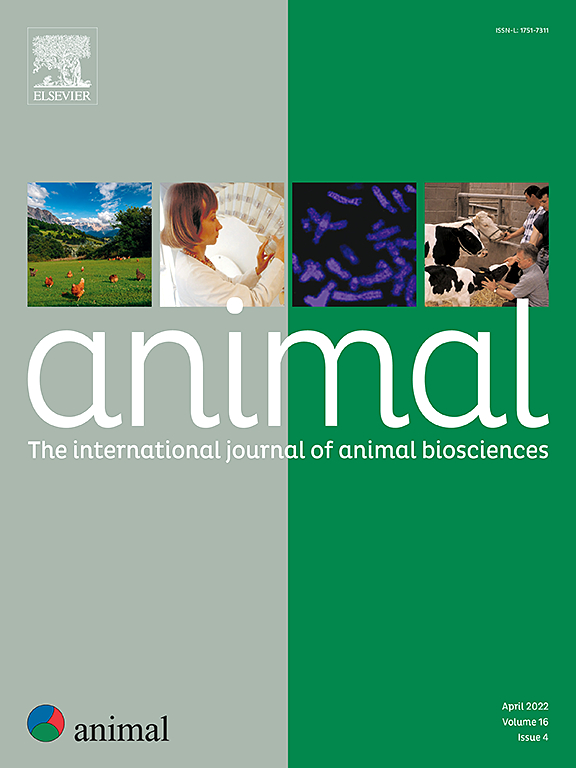Estimates of genetic parameters and genetic trends for milk production traits in Murciano-Granadina goats
IF 4.2
2区 农林科学
Q1 AGRICULTURE, DAIRY & ANIMAL SCIENCE
引用次数: 0
Abstract
Dairy goat production plays a vital role in meeting nutritional needs and supporting rural livelihoods. This study estimated variance components and genetic parameters for daily milk yield (DMY), daily milk fat yield (DMFY), and daily milk protein yield (DMPY) in Murciano-Granadina goats. The study used data collected from 2015 to 2021 in Ghaleh-Ganj dairy goat farm in Kerman province, Iran. R software was used to evaluate environmental effects, examine genetic and phenotypic trends, and determine genetic-phenotypic correlations. The best model was determined based on Akaike’s Information Criterion. (Co)variance components and heritability were estimated using the AIREMLF90 software. For DMY, DMFY, and DMPY, the estimated heritability was 0.21 ± 0.02, 0.13 ± 0.01, and 0.17 ± 0.02, respectively. The repeatability estimates were moderate, ranging from 0.40 for DMPY to 0.46 for DMY. The contribution of animal permanent environmental effect to the total phenotypic variance was estimated as 21, 48, and 17% for DMY, DMFY, and DMPY, respectively. The estimates of genetic correlations between DMY-DMFY, DMY-DMPY, and DMFY-DMPY were 0.62 ± 0.0140, 0.67 ± 0.010, and 0.85 ± 0.009, respectively. Estimates of phenotypic correlations among traits ranged from −0.12 ± 0.006 for DMY-DMFY and DMY-DMPY to 0.35 ± 0.005 for DMFY-DMPY. This investigation revealed moderate heritability and positive and moderate genetic correlations among the observed dairy traits. These results can be used to establish a breeding plan to improve the production level of Murciano-Granadina goats.
穆尔西亚诺-格拉纳迪纳山羊产奶性状遗传参数和遗传趋势的估计
奶山羊生产在满足营养需求和支持农村生计方面发挥着至关重要的作用。本研究估计了穆尔恰诺-格拉纳迪纳山羊日产奶量(DMY)、日乳脂产量(DMFY)和日乳蛋白产量(DMPY)的方差组成和遗传参数。该研究使用了2015年至2021年在伊朗克尔曼省Ghaleh-Ganj奶山羊场收集的数据。使用R软件评估环境影响,检查遗传和表型趋势,并确定遗传-表型相关性。根据赤池信息准则确定最佳模型。采用AIREMLF90软件估计Co方差成分和遗传力。DMY、DMFY和DMPY的估计遗传力分别为0.21±0.02、0.13±0.01和0.17±0.02。重复性估计是中等的,从0.40的DMPY到0.46的DMY。动物永久环境效应对DMY、DMFY和DMPY总表型方差的贡献分别为21.8%、48%和17%。DMY-DMFY、DMY-DMPY和DMFY-DMPY的遗传相关性分别为0.62±0.0140、0.67±0.010和0.85±0.009。性状间的表型相关性估计范围从DMY-DMFY和DMY-DMPY的- 0.12±0.006到DMFY-DMPY的0.35±0.005。结果表明,各奶牛性状的遗传力中等,遗传正相关和中等相关。这些结果可用于制定育种计划,以提高穆尔西亚诺-格拉纳迪纳山羊的生产水平。
本文章由计算机程序翻译,如有差异,请以英文原文为准。
求助全文
约1分钟内获得全文
求助全文
来源期刊

Animal
农林科学-奶制品与动物科学
CiteScore
7.50
自引率
2.80%
发文量
246
审稿时长
3 months
期刊介绍:
Editorial board
animal attracts the best research in animal biology and animal systems from across the spectrum of the agricultural, biomedical, and environmental sciences. It is the central element in an exciting collaboration between the British Society of Animal Science (BSAS), Institut National de la Recherche Agronomique (INRA) and the European Federation of Animal Science (EAAP) and represents a merging of three scientific journals: Animal Science; Animal Research; Reproduction, Nutrition, Development. animal publishes original cutting-edge research, ''hot'' topics and horizon-scanning reviews on animal-related aspects of the life sciences at the molecular, cellular, organ, whole animal and production system levels. The main subject areas include: breeding and genetics; nutrition; physiology and functional biology of systems; behaviour, health and welfare; farming systems, environmental impact and climate change; product quality, human health and well-being. Animal models and papers dealing with the integration of research between these topics and their impact on the environment and people are particularly welcome.
 求助内容:
求助内容: 应助结果提醒方式:
应助结果提醒方式:


